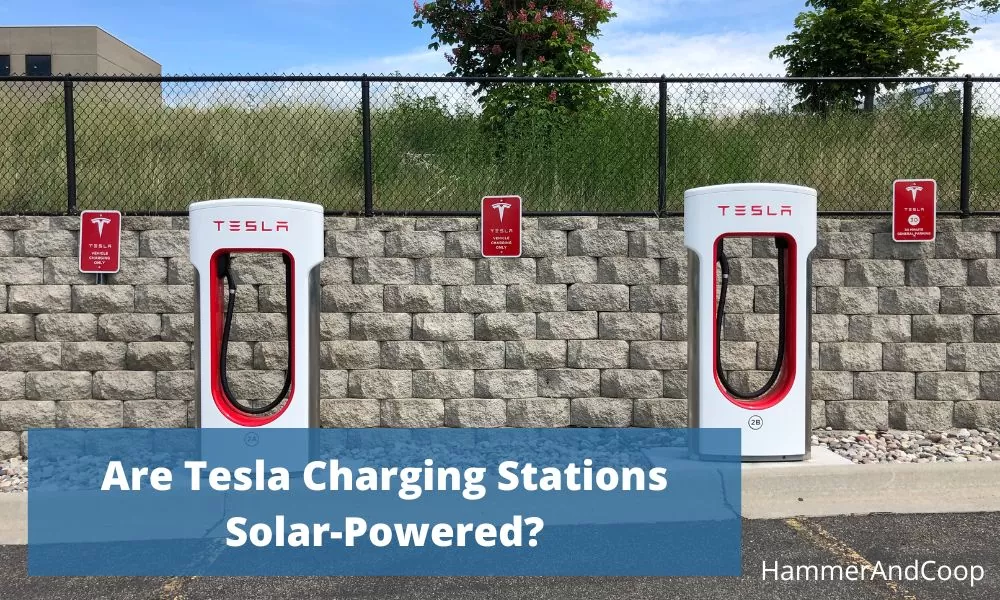It is barely news that Tesla is a front liner in revolutionizing automobile tech. You might have many questions about how the cars work and everything associated. You may ask, ‘are Tesla charging stations solar-powered?’
Yes, most Tesla charging stations generate power from solar panels. This means they draw energy from solar panels. Then, they store the energy in battery packs instead of a direct connection to the electricity grid.
This post will tell you all you need to know about Tesla’s charging stations.
How The Charging Stations Work
These panels harness the sun’s rays to deliver power directly to your car. The sun is a significant energy source because it’s free and abundant—but you can’t just go into it yourself and start generating electricity! That would be dangerous for humans at temperatures above freezing (or below). Instead, we have special devices called photovoltaic cells (or PV cells) that do all the work by converting light into electricity.
These PV cells are essential to the entire system and are delicately important in the working system of Tesla charging stations.
Tesla Charging Station Locations
You can find Tesla charging stations all across the country. They are in shopping malls, hotels, restaurants, and other public places. There are also charging stations present in residential areas and rural regions of California. And yes, there are Tesla charging stations in urban areas too!
You can find the nearest Tesla charging station to you on their website here.
Tesla Charging Station Speeds
One of the most important factors to consider when deciding whether or not to use a Tesla charging station is the charging speed. There are three different Tesla charging stations, and each of them charges at a different rate:
One hundred and twenty kilowatts (120 kW). The standard Tesla Supercharger can charge up to 120 kW. So, it can fully charge your car in as little as 20 minutes.
145 kW. Some newer Superchargers can pump out 145 kW per hour instead of 120 kW per hour. These faster chargers will still take approximately the same time—about 15-20 minutes—to recharge your vehicle; they get you back on the road more quickly than usual.
50 kW. Suppose you’re planning on staying near one location for over four hours (overnight in most cases). In that case, having access to a Destination Charger may be helpful for overnight recharging needs. Since these stations pull less power than either type of Supercharger but still let you plug in safely without risking damage from overvoltage conditions because of poor wiring or other factors.
Supercharger Stations Are Grid-Tied
One of the main selling points of Tesla chargers is that they’re solar-powered. This is true in some instances, but not all—and it depends on your definition of “solar-powered.” Solar panels generate electricity for power stations, which may be on-grid or off-grid (also called stand-alone). Grid-tied means that a system is connected to an electric utility and can draw from or contribute to the grid at any time—this includes the Supercharger stations.
Tesla Motors Inc.’s Supercharger network consists of DC fast-charging stations and AC quick charging stations. The DC fast chargers use solar panels as well as traditional grid power sources; however, they do not rely entirely on either source since they only provide electricity during peak hours when demand is highest. This is typically between 5 p.m.-11 p.m.
Not All Tesla Charging Stations Are Solar-Powered
Yes, the vast majority of Tesla charging stations are solar-powered. However, not all the stations are solar-powered. You can tell if a charging station is solar-powered because it will say “Solar” or “Solar-Powered” on the sign. Additionally, at most locations where there are multiple stalls for charging cars, you see two different signs—one for each stall—the second sign will usually show that one stall is solar-powered while the other isn’t.
So, while it is evident that, for the most part, Tesla has chosen to go with solar-powered charging stations, they also have alternative options. Although, recently, the company announced in 2021 that they plan to generate all the energy for their Superchargers from renewable resources. However, some charging stations are still powered by the grid or any source of electricity used in the locality.
The Charging Stations Are Environmentally Healthy
Solar panels are the primary source of power for most superchargers. They provide a renewable energy source that is more efficient and cost-effective than other energy sources.
What does this mean for you? If you plan to drive a Tesla near a Supercharger, it’s essential to know that the sun powers most of them. So when you’re charging up at one of these stations, don’t worry about adding extra pollution to the environment—you’re doing something good!
Conclusion
Tesla created a unique and self-contained charging station that is green and practical. This article has explored how Tesla charging stations differ from other electric car chargers – such as how they don’t require external power sources to operate or charge multiple vehicles at once with one unit. Tesla’s proprietary design provides an innovative solution for our energy needs moving into the future. It also serves as an environmentally responsible option that helps reduce greenhouse gases produced by electric vehicles today. We hope this article helps shed some light on these exciting developments!
Hello Automotive Gear Lovers!
Sourav Biswas is here! I write for the VehicleOnly Automotive Blog and am passionate about automotive tools. I am also a publisher on Amazon & Medium.
VehicleOnly is always on the lookout for the best brands and products. My experience has already helped several purchasers save money.
My goal is to help newbies locate the right automotive gears and parts for their vehicles. This is all about my short bio. For more information, go here!

